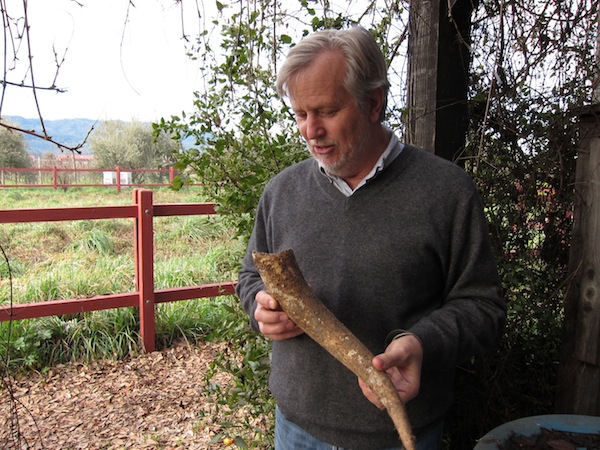Chidaine Montlouis and wild mushroom pie
There’s a white, chalky flintiness everywhere in Montlouis, a long under-appreciated region in France located across the Loire River from the Vouvray AC; the latter better known around the world for its soft, flowery fresh, demi-sec (“off-dry”) styles of whites made from the Chenin blanc grape.
Montlouis is also planted exclusively to Chenin blanc; but because its best whites are probably its dryer ones, flinty or chalky sensations seem more pronounced in Montlouis; the understanding of which doesn’t require much of a leap after you see its whitish soils, which consist of almost no clay, but rather a predominance of silex (finely ground flint), sand and limestone. Although in actuality, it's the searing acidity of this cold climate grown white wine that mobilizes the sensory quality commonly known as "minerality."
 |
| Domaine Chidaine in Montlouis. |
Not to say that each sip of the 2006 Francois Chidaine Montlouis Clos du Breuil (about $23) tastes like wet rocks. The terroir is a subtle undertone in this wine, which exudes more of a succulent, melony fruitiness in the nose, tinged with a wildflower honey, a whiff of bread yeast, and even tropical suggestions (like caramelized banana). On the palate, the honeyed fruit sensations mesh with a pointedly green apple tartness in a medium-full body, and the wine finishes as dry as, well, rocks.
If you take the trouble to seek out and appreciate this wine, you might go further and taste more of Chidaine’s cuvées (he bottles several each year, the Clos du Breuil from one of his oldest plots, and usually among the driest); illustrating what many connoisseurs believe to be as compelling a testament to the link between low-intervention, biodynamic winemaking and purest possible expression of grape and terroir as you can find anywhere in the world. Most certainly, the naturally perfumed character of the Chenin blanc and the limestone crusted soil (which heightens soil pH and translates into higher acidity in grapes) contribute to the overall effect of resulting wines.
When matching food with such unique wines, I like to highlight the attributes, which also rounds them out. Because of the tartness, for instance, slightly sharp, earthy cheeses like fetas and chèvres make sense, smoothing out the wine’s sharper edges. If you choose a smoked chèvre, the smokiness plays up the wine’s flinty, minerally qualities, and you begin to better appreciate the complexity of good Montlouis (combining chèvre with, say, smoked salmon or wood grilled oysters would achieve the same effect).
When it comes to dishes: Yes, briny foods that like tart edged whites (oysters, crab, bouillabaisse, etc.) make sense. Or, you could emphasize both the flinty and fruity qualities of the Montlouis by this recipe for a wild mushroom tart; teeming with aromas of woodsy earth, while a creamy béchamel underlines the luscious, tropical notes of the wine.
 |
| Wild mushroom tart. Charlotte Puckette. |




Comments
Post a Comment